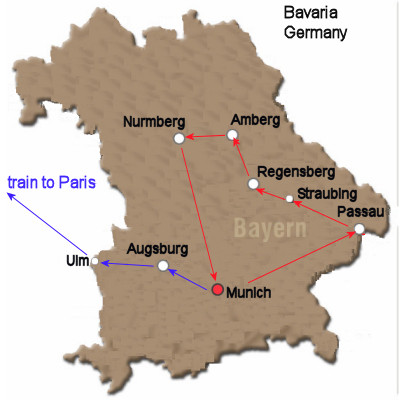
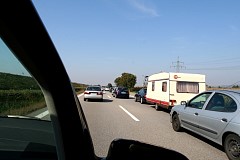
|
Sunday, September 23, 2007.
Regensburg, Bavaria
We left the farm to drive to Regensburg via the Autobahn. Here we are in stopped traffic - the
speed limit on the famous road system is effectively zero.
|
|
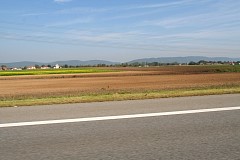
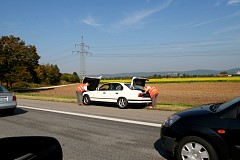 With the Bavarian Woods in the background, the picture on the far left shows a Chinese ring neck
pheasant in the foreground. Not tremendously exciting, I know. I like chasing after them
in the States ... In the picture on the right note that it's the law in Germany that you must
don these safety vests if your car breakdowns - I hope this requirement never
makes it to the United States.
With the Bavarian Woods in the background, the picture on the far left shows a Chinese ring neck
pheasant in the foreground. Not tremendously exciting, I know. I like chasing after them
in the States ... In the picture on the right note that it's the law in Germany that you must
don these safety vests if your car breakdowns - I hope this requirement never
makes it to the United States.
|
|
|
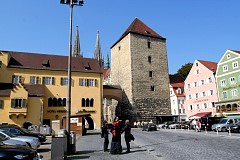
Regensburg is a city with more than 2,500 years of history. Today the population is
around 130,000. The Celts arrived
somewhere around 500 B.C.; four centuries later, around 90 B.C.,
the Romans established a permanent fortress.
Because Regensburg escaped relatively undamaged from Allied bombs in World War II,
its architectural heritage consists of original buildings instead of postwar replicas.
There are over 1400 medieval buildings in Regensburg.
The large stone edifice in the background is the remaining gate from the medieval city wall.
In the foreground are some young folks dresses in Goth attire.
|
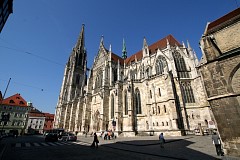
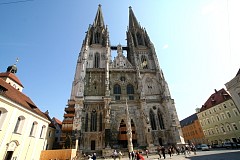 The Dom (Cathedral) of St. Peter is a very interesting example of pure
German Gothic and counts as the main work of Gothic
architecture in Bavaria. It was founded in 1275 and completed in
1634, with the exception of the towers, which were finished in 1869.
The Dom (Cathedral) of St. Peter is a very interesting example of pure
German Gothic and counts as the main work of Gothic
architecture in Bavaria. It was founded in 1275 and completed in
1634, with the exception of the towers, which were finished in 1869.
|
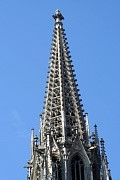
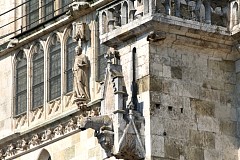
When the cathedral was cleaned a number of years ago, it
became possible to see two types of stone in the facade:
a cream-colored limestone and a softer green sandstone that
was used for repairs and additions in the 1800s. The green
blocks are being replaced gradually with limestone from the
Czech Republic that matches the original material.
|
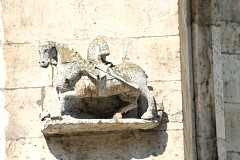
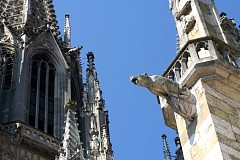
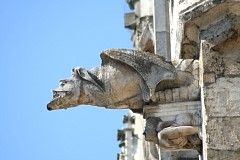
|
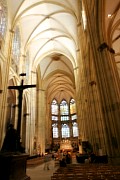
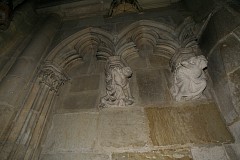
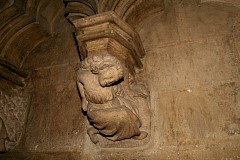 The interior picture (far left) is terrible, but I include it anyway to give some idea
of the interior.
The interior picture (far left) is terrible, but I include it anyway to give some idea
of the interior.
|
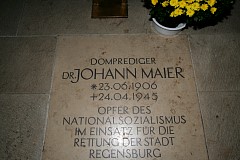 Johann Maier was from 1939
until his death a preacher at Regensburg Cathedral.
On 22 April, 1945 United States Army tanks reached the Danube.
The next day, an excited crowd of people gathered at the Moltkeplatz - nowadays
known as Dachauplatz. Johann Maier was there and bade the crowd be quiet as he
had something to say. He called for the town's peaceful hand over. Even
before he had finished his speech, he was seized by plainclothes police. That evening, Maier
was sentenced to death by hanging.
On the morning of 24 April 1945, Maier was hanged at Moltkeplatz.
About his neck, he wore a sign that said "I am a saboteur". Later the
Wehrmacht and the SS both fled southwards out of town: Regensburg fell without a fight.
Johann Maier was from 1939
until his death a preacher at Regensburg Cathedral.
On 22 April, 1945 United States Army tanks reached the Danube.
The next day, an excited crowd of people gathered at the Moltkeplatz - nowadays
known as Dachauplatz. Johann Maier was there and bade the crowd be quiet as he
had something to say. He called for the town's peaceful hand over. Even
before he had finished his speech, he was seized by plainclothes police. That evening, Maier
was sentenced to death by hanging.
On the morning of 24 April 1945, Maier was hanged at Moltkeplatz.
About his neck, he wore a sign that said "I am a saboteur". Later the
Wehrmacht and the SS both fled southwards out of town: Regensburg fell without a fight.
|
|
|
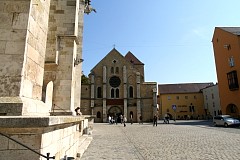
Across the way, next to the cathedral the old parish church of St. Ulrich is a good example of the Transition
style of the 13th century, and contains a valuable antiquarian collection.
It houses the diocesan museum for religious art.
|
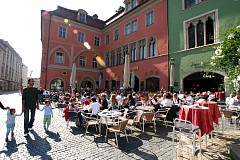
It's Sunday morning and these people are sitting in the cafe across the street from the
Cathedral.
|
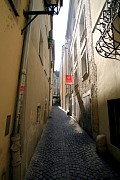
I have learned to recognize streets laid out in medieval times in Bavarian towns.
|
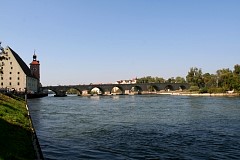 In 1135-46 a bridge across the Danube, the Steinerne Brücke, was built. This
stone bridge opened major international trade routes between Northern Europe and Venice,
and this started Regensburg's golden age as a city of wealthy trading families.
Regensburg became the cultural center of southern Germany and was
celebrated for its gold work and fabrics.
The knights of the 2nd and 3rd crusade used this bridge to cross the Danube on
their way to the Holy Land.
In 1135-46 a bridge across the Danube, the Steinerne Brücke, was built. This
stone bridge opened major international trade routes between Northern Europe and Venice,
and this started Regensburg's golden age as a city of wealthy trading families.
Regensburg became the cultural center of southern Germany and was
celebrated for its gold work and fabrics.
The knights of the 2nd and 3rd crusade used this bridge to cross the Danube on
their way to the Holy Land.
|
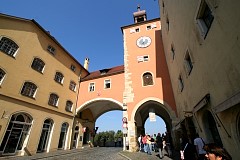
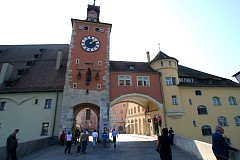
Here are both sides of the gate on the Old City side of the bridge.
Bridge Tower was a fortified gate on the southern end of the Steinerne Brücke
For most of the bridge's history, the narrow arch was the only
entrance to the city.
|
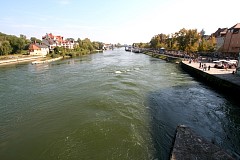
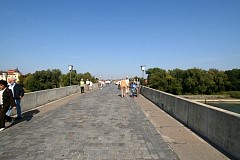
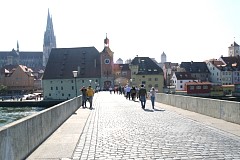
|
|
The city of Regensburg is located at the confluence of the Danube and Regen rivers - the\
Regen joins the Danube out of site downstream from the bridge.
|
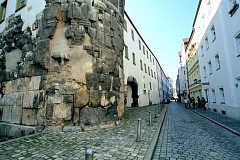
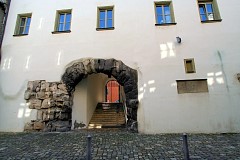 The picture on the left shows what is left of the Porta Praetoria (main gate) of
Ratisbona, originally Castra Regina, meaning "fortress by the river Regen".
The Roman fort Castra Regina was built In 179 by
Legio III Italica during the reign of Emperor Marcus Aurelius. The picture
on the right shows part of the wall and gate of the fort incorporated into a house.
The picture on the left shows what is left of the Porta Praetoria (main gate) of
Ratisbona, originally Castra Regina, meaning "fortress by the river Regen".
The Roman fort Castra Regina was built In 179 by
Legio III Italica during the reign of Emperor Marcus Aurelius. The picture
on the right shows part of the wall and gate of the fort incorporated into a house.
|
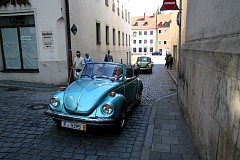
While we were standing on the street a car club comprised of Volkswagon owners came
roaring by in a procession of perhaps 40 cars.
|
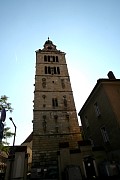 This unprecedented stone bridge across the Danube here in Regensburg
opened major international trade routes between Northern
Europe and Venice, and much of Regensburg's medieval city center
was built by wealthy merchant families over the next few centuries.
These traders had no compunctions about flaunting their wealth;
some of their houses had purely decorative towers that made them
the mansions of the Middle Ages. For defense, entrance to the towers was
only allowed on higher floors via a ladder.
This unprecedented stone bridge across the Danube here in Regensburg
opened major international trade routes between Northern
Europe and Venice, and much of Regensburg's medieval city center
was built by wealthy merchant families over the next few centuries.
These traders had no compunctions about flaunting their wealth;
some of their houses had purely decorative towers that made them
the mansions of the Middle Ages. For defense, entrance to the towers was
only allowed on higher floors via a ladder.
|
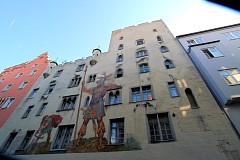
This fresco from 1573 is of David and Goliath and is painted
on the wall of the Goliath Haus. I guess it's touched up
as needed through the ages. Regensburg has been called the most northern city in Italy and
has a definite Italian look to the houses.
|
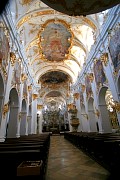
This is the interior of the Benedictine Monastery of St. Emmeram, which is both a parish
church and the personal chapel of the Thurn and Taxis family.
Check out the Baroque plaster and gilding
layered onto a pre-Romansque building.
The Princely House of Thurn and Taxis (German:
Das Fürstenhaus Thurn und Taxis) is a German family that
was a key player in the postal services in Europe in the
16th century and is well known as owners of breweries and builders of countless castles.
|
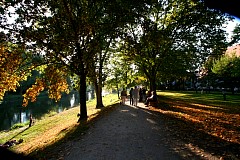
"The Plan" according to Frieda is to hand me off to another cousin we met up with
at the cathedral here in Regensburg.
The are walking up ahead while I pause to take a picture along the river.
Lucky for me, Christal has been an English teacher, so communication with my relatives
is easy.
|
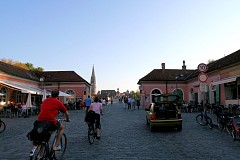
We have crossed the Danube using a downstream bridge and are going to re-cross
the Danube using the Steinerne Brücke up ahead.
|
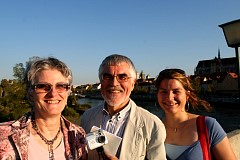
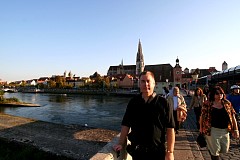 Here is Christal, Joseph, and daughter Anna. My great grandparents had six children.
Two of the daughters entered orders and lived to a very old age serving in the Philippines.
Frieda and Agnes's grandfather and my grandfather were brothers, Joseph's grandmother and
my grandfather (and Frieda and Agnes's) were sister and brother. Karl, who I mentioned
on the web page about Wiedenhoven, is the son of
the third brother.
Here is Christal, Joseph, and daughter Anna. My great grandparents had six children.
Two of the daughters entered orders and lived to a very old age serving in the Philippines.
Frieda and Agnes's grandfather and my grandfather were brothers, Joseph's grandmother and
my grandfather (and Frieda and Agnes's) were sister and brother. Karl, who I mentioned
on the web page about Wiedenhoven, is the son of
the third brother.
|
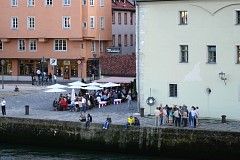
This is a shot of the Brauerei Kneitinger, which has been at this site since 1530, meaning it
has served food here for 477 years!
|
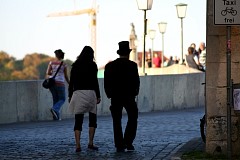
Apparently the young man in this photo wears a top hat because he is enrolled in a trade
apprenticeship and by wearing it he is entitled to monetary discounts from merchants.
After this picture was taken we walked through the city to Josephs mini-van and
Anna drove us from Regensburg to Amberg. We stayed up talking rather late for
a Sunday night.
|